Warning: very long article.
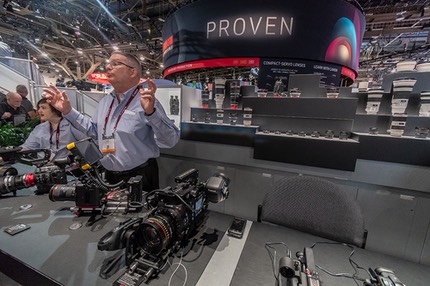
The National Association of Broadcasters (NAB) trade show in Las Vegas each year is one of the biggest, if not the biggest gathering, of both the world of audio and video practitioners and product producers. While there’s no emphasis on still photography at the show, there are always plenty of goodies that are right on the periphery that still photographers might be interested in. That’s especially true now that all of our DSLR and mirrorless cameras can do video.
Unlike two years ago, where I had a fixed agenda going into the show and some very specific interviews I wanted to do, this year I took a much more casual approach. I scheduled booth interviews with a few companies you might recognize—Fujifilm, Nikon, Sigma, and Sony—but for the most part I decided to spend my two days at the convention center mostly just wandering and seeing what caught my interest. So what I’ll present here will be a bit random.
I’ll cover product announcements, things that sparked my interest, the Nikon booth, and conversations I had. Each has a boldfaced header to identify it if you want to skip over to what interests you.
Product Announcements
Let’s start with product announcements that are close to the interchangeable lens camera world.
Probably the biggest thing of interest that I could hear buzz about was Apple’s announcement of ProRes RAW, and the companies that announced support of it (Atomos, DJI, and Panasonic being the first; but I’m sure there will be more based upon conversations I had at the show, just no announcements yet).
The video world is much like the still world: lots of proprietary recording formats, and that’s a big burden on the post processing workflow. In video we often have to transcode what was recorded into something else in order to enable real time editing of our work, and AVCHD type compression is insidious on CPU cycles and not something you want to directly edit. A lot of video professionals prefer to shoot in Apple ProRes compressed or Avid’s DNxHD compressed formats for that reason: both those formats are directly editable on the RLEs like Final Cut Pro or Blackmagic Design DaVinci, and don’t have the same CPU/GPU strain. I’ve edited 4K ProRes on my laptop without it burping.
Having a semi-common raw file is going to impact video workflows, for sure. And this applies to Nikon and Canon DSLRs, where you might be recording to an external HDMI box, like the Atomos Shogun Inferno or Sumo 19, both of which are getting firmware updates to support ProRes RAW. DJI’s Zenmuse X7 camera gets an update to support ProRes RAW next month. Panasonic’s EVA1 also is getting a firmware upgrade.
Of course there’s usually a downside to shooting raw video: file size escalates dramatically. That’s one of ProRes RAW's interesting attributes. If I understand it correctly, ProRes RAW requires a fraction of the data rate an uncompressed 12-bit raw video file would. In other words, it preserves the ability to make big grading changes in post (raw) while giving the size benefit of a mostly artifact free compression (the ProRes part). If that didn’t make sense to you, try this: take a raw data stream and compress it and you have ProRes RAW. You haven’t changed bit depth or color retention or scaled anything. The results are not visually lossless, but it’s highly artifact free given the nature of Apple’s video compression algorithms.
As I understand it, there are two ProRes RAW formats: straight ProRes RAW, which is the data rate equivalent of ProRes 422HQ, and ProRes RAW HQ, which is equivalent of ProRes 4444XQ.
Apple themselves updated Final Cut Pro to version 10.4.1, and that program now has direct support for ProRes RAW files. You can import those files directly and begin immediately working on them (no transcoding).
If you’re interested in learning more about Apple ProRes Raw, Apple now has a white paper you can read.
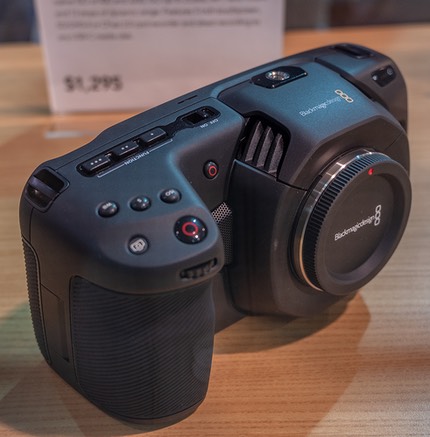
Blackmagic Design announced a new Pocket Cinema Camera, now with 4K at 60 fps. Curiously, the new version of the camera keeps the m4/3 active lens mount, but the camera is now seriously pushing the concept of “pocket.” It’s huge. That does include a very nice and deep hand grip, but overall this is a big ugly duckling of a camera that looks like it was designed in the 1970s, and with a ton of controls all littered on the right side of the camera (as you’re handling it).
Out back there’s a 5” touch screen (did I say huge?). Inside we get an m4/3-sized, 8mp sensor (4096x2160) capable of 12-bit raw and thirteen stops of dynamic range. There’s no additional crop this time around, so you’re getting the full width of the m4/3 sensor size. The old Pocket Cinema Camera had an effective 2.7x crop, the new one has a 2x crop, just like m4/3.
The camera records 12-bit CinemaDNG Raw or 10-bit Apple ProRes 422HQ. Blackmagic has changed from Nikon EN-EL20 batteries to Canon LP-E6 batteries. As usual, Blackmagic Design isn’t leaving much off the specs: in addition to the usual 3.5mm stereo microphone jack there’s a mini-XLR input with phantom power, something you don’t find in a lot of the low-end gear. Another example: you can hang an external SSD off the USB-C port and record directly to that! Tripod socket (1/4” thread) mounts show up on bottom and top of the camera, though I’m pretty sure I’d either want a cage or hot shoe instead. Yes, I know that the top screw mount can be useful for securing a cage, but for run-and-gun use I’d rather have a cold shoe, I think.
The camera has both a CFast 2.0 and a UHS-II card slot, can be controlled from Bluetooth, and includes a full copy of DaVinci Resolve Studio (normally) US$299. That last part is the way the Blackmagic Design folks are justifying the price increase, by the way, since the new US$1250 price is just about one Resolve Studio away from the old price. The old Pocket Cinema Camera stays in the lineup at US$995.
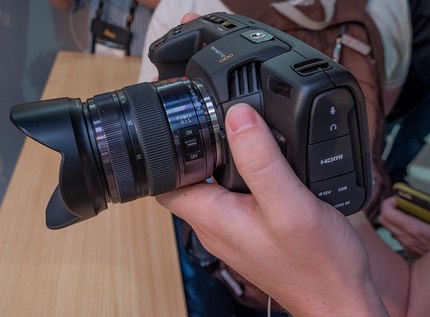
In person the new 4K Pocket Cinema Camera feels decent in the hand, though I’m not at all convinced about the way the buttons and controls are strewn about or how cables will interact with holding it. I need more time with the camera to evaluate that. The big touch screen is nice, though. Yes, you can shoot stills with it, though it definitely didn’t feel optimized for that.
If you’re used one of the URSA cameras from Blackmagic Design, you’ll feel right at home with the on-screen interface, as it’s the same thing (Blackmagic OS).
What Blackmagic Design didn’t exactly announce is availability. Only “later this year.” The whisper date is September, but BMD often has trouble getting things to final production on their expected date.
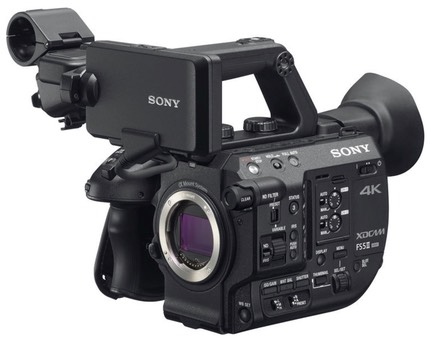
Sony announced the FS5 Mark II. This is a very serious video camera, but it uses Sony FE mount lenses, so it’s very relevant to Sony A7/9 mirrorless shooters that also want a pro-grade, dedicated video camera in their gear set.
All of the Mark II changes appear to be internal. Body size, style, layout is the same as the original (a dial changed color). Inside, we get new picture profiles and color science taken from Sony’s Hollywood high-end product, the Venice. Sony made specific claims about more accurate skin tones, so that alone is something the serious video shooters will be looking at closely. You can now shoot four second bursts at 4K/UHD and 120 fps internally (or 240 fps continuously in 2K raw). We get a new Instant HDR workflow. Plus the Mark II incorporates all the other for-purchase firmware upgrades that Sony produced for the original.
The original FS5 will stay on the market at a lower price (without the firmware upgrades that expanded recording options, of course). Shipments for the Mark II will start in May, and the body-only price is US$4750.
Others I talked to after the Sony announcement on Sunday were underwhelmed. Not a lot of tangible changes that are instantly promotable. Personally, I think this is exactly what you do to protect key products: even if you don’t have those exciting and innovating new feature things that get all the Internet hype, you want to continue to keep your products right at the level of what you know how to do. By now having a lower-priced version of the same product, you also distribute your sensor costs over more sales, helping everyone. (And as I reminder, this is exactly the kind of update that I would have suggested for the D5 and D500: make sure all the latest stuff is available in the key models as an “s” upgrade; the D850 has features and refinements not in the D500, for instance.)
There were plenty of new lenses at the show for the cine side. I’ll be adding these to my databases as I get time. None rose to the level that I feel I need to highlight them here (other than a couple, below), but trust me, cine lenses are popping out of the woodwork everywhere.

Caught this fully automated tripod/head from Edelkrone wandering down the hall. There booth is over there… (I think he got asked that a lot)
Things That Sparked my Interest
One question I get asked a lot is “which monitor should I get?” I have to admit to not having a strong answer for that, as I’m using a Retina 5K iMac these days and I just don’t tend to pay a lot of attention to what’s new in the monitor realm.
But I decided to pay a little attention to monitors, because the NAB show is a good place to see many of the high level monitors that cross over into serious photography use. I’ll cut to my short answer: NEC, HP, and Eizo. Realistically, if you’re looking for something that is pro grade and reliable, you’re not going to go wrong with the right monitor choice from one of those three.
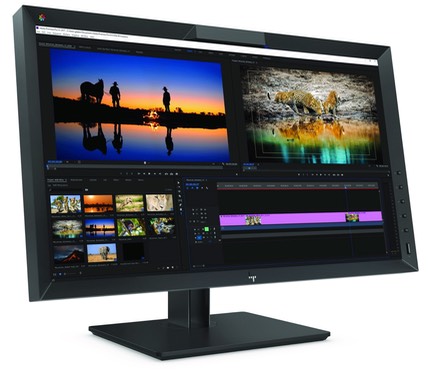
And it so happens that HP was showing their brand new Dreamcolor monitors: Z27x G2 (shown above), and Z31x G2 (27” and 31”, respectively). These have built-in and schedulable color calibration, basically resolve the DCI-P3 color space (same as Apple is doing on the Retinas), and are really nice in terms of all the other bits and pieces (firmware upgradeable by built-in USB, for instance, and yes, HP has been updating the Dreamcolor monitor firmware regularly with new features and capabilities—I even managed to suggest one such thing that the product manager I talked to is going to bring back into the development team, since it will be easy to make that change).
The 27” sells for US$2000, the 31” for US$4000, a really good price point for monitors this good and with so many features. I spent a fair amount of time looking at them, and was impressed.
Meanwhile, Eizo was showing a new ColorEdge CG319x monitor (31”) with many of the same attributes, and just as impressive. Including DCI-P3. But no availability date and price yet.
Hmm, so maybe we should talk about DCI-P3?
Introduced as a standard in 2007, DCI-P3 is very similar to AdobeRGB in terms of the size of the color space. It’s virtually the same size, it just adjusted to coloration standards that have long been growing out of the digital cinema side: all current digital cinema projectors use the DCI-P3 space. I’ve written about the differences before, but the primary difference between DCI-P3 and AdobeRGB is that DCI-P3 extends a bit further into the reds, AdobeRGB a bit more into the greens. Not really enough difference get concerned about.
But here’s the thing: DCI-P3 won. I see almost no one targeting AdobeRGB any more in the monitor industry. Apple picked DCI-P3 for all their display technologies, even the laptop I’m writing this on. And it’s becoming more clear that the biggest and most interesting monitor companies are doing the same. The bottom line is this: DCI-P3 is a perfect match for display technologies, even Hollywood ones, and it’s a fairly close match for print technologies (and certainly better than sRGB).
So to expand on my short answer before: pick an NEC, HP, or Eizo, and make sure it is 98% or higher on the DCI-P3 color space compatibility. I’m pretty sure that if you calibrate properly on one of those, you’ll be happy (and that’s despite Lightroom using the larger ProPhotoRGB color space).
Moving on.
Tokina showed new 11-20mm t/2.9 Cinema ATX and 105mm f/1.5 Vista lenses. The Vista adds to the existing 18mm, 25mm, 35mm, 50mm, and 85mm prime set and provides the fastest t/stop we’ve seen at 105mm, though it comes in at a hefty US$7499. The primes are all full frame capable, by the way.
Meanwhile, the 11-20mm gets the same cinemafication treatment that the older 11-16mm gets, complete with fully geared rings and very visible markings. The 11-20mm costs US$1999. Both lenses arrive in September.
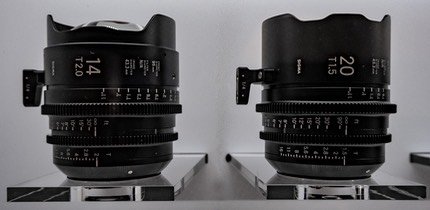
Sigma also has cinema versions of the 14mm and 20mm Art lenses I reviewed last week.
Sigma showed me their three latest lenses. The 14-24mm f/2.8, of course, is deeply of interest to Nikon DSLR users, as it represents a less expensive way of getting to that third fast zoom in the triad. In the context of a show you can’t do much, but like the other recent Art lenses, the build quality seems high and appropriate.
Yes, I asked about where the new 70mm macro in the F-mount is. The Sigma representatives seemed to believe it’s coming, but they couldn’t actually confirm that. The old version is a wicked sharp lens and a great macro choice if you need that focal length. The optical formula in the new versions is exactly the same, so it would be nice to have the build quality improvements and the electrical aperture control. I asked Sigma to try to verify that the Nikon F mount version will finally appear, so hopefully I’ll get that answer soon.
Last, we have the Sigma 105mm f/1.4 Art. It’s like a miniature 200mm f/2: huge front element and front presentation, a really densely-packed lens that has heft to it. Again, not really a place to shoot with it, but I’ll be reviewing it as soon as I can get around to.
Finally, the winner is…
Wait, what was the race?
Last time I was at NAB doing a full booth-to-booth walk (two years ago), we were at the Thunderbolt 2 to 3 transition, and it was messy and many vendors weren’t certain of the exact future. Well, they all seem to be sure now.
Virtually every drive, NAS, SAN, RAID, card reader vendor I talked to was fully committed to Thunderbolt 3 at this year’s show. All in. Some of them will also sell you the same basic product in USB 3.1 form, but they pretty much all want to sell you Thunderbolt now, and they all point to the performance differences of a full throttle Thunderbolt 3 versus USB 3.1, even Gen 2.
That certainly wasn’t the case two years ago. While the promised speeds of Thunderbolt were enticing, the licensing fees, technical details, and the awkwardness of the generation transition pretty much had all the vendors telling me that they weren’t sure Thunderbolt was the future. It was also unclear if anyone other than Apple on the computer side was really committing to Thunderbolt 3. This year? Thunderbolt 3 is the future. Or wait, it might be the present now.
It didn’t matter who you asked: Thunderbolt 3 with USB 3.1 Gen 2 fallback. Rugged drive for the outback? LaCie Rugged RAID Pro. 2/4/6/8 bay desktop RAID? Pegasus, Akitio, OWC, et.al., all have you covered.
The Nikon Booth
Okay, you all wanted to know what Nikon was showing in their booth, so let’s do the walkthrough. It’s a wide but shallow booth. At the left end as you face it is a glass case with most of Nikon’s lens and accessory products in it (no 180-400mm f/4; more on that in a bit). The basic trade show “see we’ve got a lot of stuff” presentation, complete with signs indicating that the case was under 24-hour surveillance (a lot of implied dollars sat in that case).
In the middle of the booth we had a faux demonstration of how the Mark Roberts’ Polycam solution works for European soccer. There are multiple cameras doing face recognition to locate players and their position on the field, even as they are moving, and then that position information is conveyed to the remote D5’s to follow them. I asked about other sports, but right now the system is designed and being used for soccer only, it seems.

I’m standing just to the left of the presenter’s stand (note the time reminder on the floor at right).
On the far right side of the booth the presentation speakers are wedged in behind the big track robots from Mark Roberts (Nikon subsidiary). I watched poor Joe McNally having to try to produce excitement for his presentation over the robot wall in front of him to where those who came for the presentation were situated. It was definitely an awkward arrangement, and felt very “tagged onto” the booth. Or maybe it was the Roberts stuff that was tagged onto the booth.
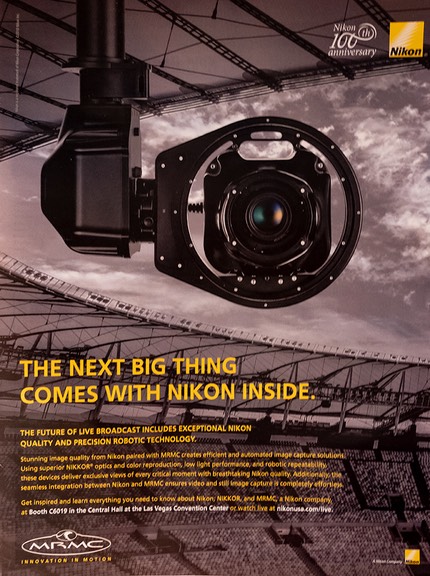
Nikon’s full-page ad in the daily news publication from the show.
Out in the lobby area outside the Central Hall Nikon has one of their robots set up with two additional cameras where you could get your “dance” recorded. The main robot was set up for doing a number of moves and slo-mo passes, and to record the whole 10-second or so thing to video that you could download immediately.
Yeah, I know what you’re thinking. Hey Thom: go record a dance move.
Do you folks actually know me? I’m so bad at that I’m almost certain that anything I did in front of the robot would go viral, for all the wrong reasons. So you’ll have to just watch their demo reel instead.
Okay, now on to the conversation at the Nikon booth.
Yes, I asked about the XQD to CFexpress transition. See the Conversations section, below, for more on that.
As it turned out, Nikon didn’t seem to know that the button+AF Area On+joystick control on the D5 was broken with the latest firmware update. That message is now headed back to Japan, and hopefully we’ll get that fixed. I also pointed out a couple of other things that users really want in the feature set that should be easy to deal with. We also talked about the new Focus Shift feature in the D850, and it appears they’ve already heard that they need a final focus point option as well as the initial point one.
While there were no answers for some of my questions—and I didn’t expect any—we did have a long, good conversation. I believe we re-established the dialogue necessary to funnel useful information back and forth with corporate.
Meanwhile, as you probably know, the 180-400mm f/4E is basically sold out. Nikon had exactly one at the show, and they were keeping it handy for the one-on-ones, not over in the glass case. I find it difficult to believe that NikonUSA was surprised at how well it sold. From a pragmatic pro’s point of view, it’s one lens that covers a lot of potential ground you might normally carry multiple lenses for, and it’s small and light enough that it can be handheld. I would have bet that there were more than enough NPS members who would instantly pick it up, and it appears that’s exactly what happened.
Unfortunately, this isn’t a lens that you just crank up the production line for. If Nikon underestimated demand as it seems they might have, this lens is going to be trickling in to stores for quite some time and tough to get.
I couldn't leave the Nikon booth without one pushback. We talked about the D850 Filmmaker’s kit, obviously. Nikon claims that this is targeted at entry filmmakers. Hmm. That didn’t seem right to me. I was carrying my D7500 with me at the time, so I picked it up and pointed to it and said “this is the camera that should be center of an entry filmmaker’s kit." The audio accessories that are in the current kit are much more at the level of the D7500. The D850 really needs to be a higher-end, serious video kit, with upgraded audio and lenses that can be focus pulled.
So when we got to that topic, Nikon basically suggested that I just use a third party one, with no recommendations. As I pointed out, what we want if that’s how video manual focus is addressed by Nikon is that Nikon “do it right” themselves. They said they’re not really in the accessories business; I pointed to the accessories sitting right behind us in the glass case. They said they don’t really do that sort of thing, but…in that same glass case was a cutaway view of the Polycam housing from Roberts with a 70-200mm that had, yes, you guessed it, geared rings for zoom and focus.
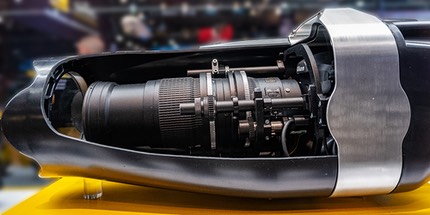
I mean, I love the video capabilities of the recent Nikon DSLRs in terms of image quality, but Nikon really needs someone on staff that is advocating for populating the rest of the lineup with the right accessories to support that. Solve user problems, not create them.
As I pointed out to the Nikon execs, that’s one reason why I loved the Mark Roberts acquisition: solving user problems is exactly what MRMC does. We need some more of that spirit to spill out of the UK and back into Japan.

Don’t want to pay the big money for the Nikon Polycom or Bolt solutions? Something a little more suitable for most of us is the Syrp Genie II. With all the goodies, you can autotrack down the slider, pan and tilt. All externally controllable just like the big Nikon solutions. Ikon will sell you similar capabilities for zoom and focus. If you haven’t figured it out yet, automation of things we used to have to rig manually is all the rage right now.
Conversations
I also had a long discussion with the founders of ProGrade Digital cards at NAB. To remind you, ProGrade was formed by former Lexar executives when Micron sold off their consumer card division.

ProGrade already has state-of-the-art UHS-II SD and C-Fast cards on the market, but the question they (and I, and everyone else) keeps getting is about XQD cards. As I’ve noted before, the follow-up in the XQD technology line is something called CFExpress. CFExpress comes in exactly the same form factor (size, shape, connectors) as XQD and uses the same PCIe technology, so two questions come to mind immediately.
First, why isn’t ProGrade making XQD cards? The answer I got is that there are Sony-specific licensing fees and license issues involved with XQD, which they didn't want to have to deal with for what they think would be a very short term solution with little volume.
Second, can I put an CFexpress card into a D500, D850, or D5 and it works? The answer to that is no. That’s particularly frustrating because ProGrade is publicly demonstrating 1TB capacity, 1400 MBs (1000MBs+ write) CFexpress cards. It seems they’re ready to roll just as soon as there are devices that can take advantage of it. That card, by the way, is Type B format with a two lane PCIe, which is the same as XQD. CFexpress allows for four lane and eight lane PCIe, as well, for even greater speeds.
So, the next question that comes to mind is this: can Nikon create firmware updates that would allow the XQD cameras to use CFexpress? Both the ProGrade executives and I believe the answer to that question to be yes. Thus, the ball is in Nikon’s court. Obviously, I asked Nikon directly. The answer to that was NikonUSA doesn’t currently know if it will happen or not; they’d need word from Japan about that.
I pointed out that at PhotoExpo in NYC late last year someone from Nikon NPS was quoted as saying it would happen, but the Nikon executives I was talking to weren’t aware of that (I sent them the exact quote via email so that they can investigate). I also urged them to seriously get some sort of answer out to customers, even if it was “we’re in the process of seeing if it can be done at the quality level we demand of our products.”
This led us into a longer discussion of reality versus perception. In reality, Nikon has the best products out there in almost every category they participate in. In perception, Nikon users are worried about quite a few things, including the future of the XQD cameras they bought. I think they understood my point, and I hope to hear back from Nikon soon with some message about what’s happening with XQD.
Back to the 1TB CFexpress card that was being demonstrated by ProGrade: while many might want the ProGrade CFexpress card being demonstrated for its capacity, what I really want it for is to speed up workflow. A 1400MBs read via an appropriate reader into a Thunderbolt 3 computer connector would mean all those images I’m shooting get from my camera to my computer much faster. Ridiculously faster.
While I’m on the subject of ProGrade, they already have UHS-II V90 SD cards on the market. These have write speeds of 200MBs and sustained reads of 250MBs, and that V90 rating indicates that they can keep up with video cameras at a 90MBs rate, which is what you need in some of the latest cameras, such as the Panasonic GH5s or AU-EVA1. These new cards come in 64, 128, and 256GB capacities with a three year warranty, and are available now.
The other product I’ve asked to try from ProGrade is their High Speed Workflow Card Reader. This small box handles SD UHS II and CFast 2.0 cards and can transfer data to a USB 3.1 Gen 2 computer at up to 1.25GBs (obviously, that’s for CFast; SD is going to run at the max speed of the card). The box comes with both Type A and Type C cables, plus has a magnetic base, which is interesting (you can hang it off the back of a MacBook Pro). And yes, no word yet on a version that’s SD and CFexpress, though they did a lot of wink wink nod nod bits as we tip-toed around that subject. Given ProGrade’s focus on state-of-the-art professional in card technology rather than consumer grade and back-filling lower grade items, I wouldn’t be surprised to see a new reader appear the minute CFexpress is really up and running on any camera device.
Meanwhile, over at (the new) Lexar I’m pretty sure that the question you wanted me to ask them is “where are the XQD cards?” Here’s your answer straight from the VPs: Lexar is now out of stock of all XQD gear they inherited from Micron (including work in progress inventory), and so is B&H and Adorama, et.al. Lexar’s new owners have now dealt with all the licensing issues with Sony and have restarted production in China. According to Lexar, they didn’t get any of the tooling from Micron, so they’ve had to build out their factory new for XQD support. But it won’t be until at least June that you see new inventory show up. Apparently this is just-off-the-press news. They weren’t going to invest in and start a new XQD production line until they had the licensing deal in place. They’ve got the licensing now, so they have started the new line.
Now that last bit—and ProGrade’s reluctance to do XQD—might tell you a little something about the behind-the-scenes game going on. Micron easily produced XQD cards (under the Lexar name) because they had a patent portfolio they could leverage against Sony’s. Apparently, to produce an XQD card you not only have to follow the standard, but you also need patent licenses from Sony. Pay to play, baby.
Still, all of you worrying that there is only one supplier of XQD should be able to relax a bit. Things will likely return to normal this summer when Lexar returns to the market with cards. And no, they wouldn’t tell me details like price and capacity.
Oh, and by the way, Firewire is dead. Done. Toast. Nothing but ashes.
Here’s what I was told by multiple vendors: they simply can’t buy Firewire controllers anymore. When they run out their current stock of parts, any Firewire device they are making will have to be end-of-lifed. So those of you hoping to keep using your old Firewire drives on new and future docks for your computers, I’m sorry to dash your hopes, but it’s time to move on.
Never offer the press a free lunch at trade shows. We’ll show up! Actually, when I got the invite to see the Digital Projection Insight Laser 8K close up and in action, I was interested even without the lunch.
Just as a reminder, 8K is 33mp. Your D8xx and A7r stills are ready for 8K displays as it is (remember Nikon promoting 8K time-lapse with the D850 even though it wasn’t actually in the time-lapse function but just a series of stills?). I was highly curious to see what well curated content looks like on state of the art projection, so I signed up for this small event hidden off in the bowels of South Hall. I’m glad I did.
First, here’s the projector:
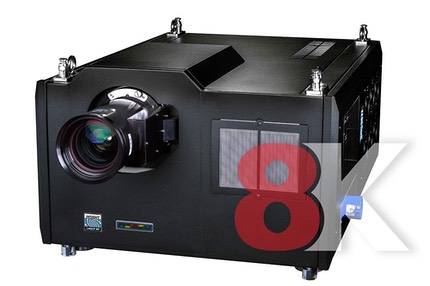
It’s a big behemoth and you don’t want to ask about its current cost (six figures). Nor do you want to ask about how to get video content into the thing, as it needs a firehose of front end. I’ve looked around a bit after this presentation: what we were looking at was pretty much state-of-the-art for projection right now.
And wow. Here I am looking at the presentation (220” diagonal screen).
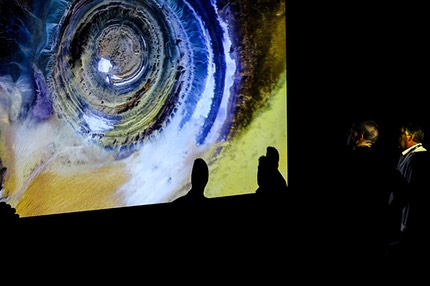
The CEO invited us to get close and look for pixels and structure in the output. You’re not really going to see that. I could see pixel structure sometimes in some of the low light samples where moving noise patterns were the giveaway, but not in well lit and well exposed material. That’s actually pretty incredible. At one point I was probably 12” from the screen looking at the display closely. The example above may look like it might be impressive, but it was one of the least impressive content they showed because it was created from a digital zoom and I could see the bicubic resampling aliasing. Still, wow.
So here’s the message to all still and video shooters: up your game. Seriously. Up your game. I could easily see even a pixel of chromatic aberration, any focus miss, diffraction impacts, and even some really minor flaring of point light sources. This projector just revealed any flaw in the 8K content. And, of course, they were showing carefully selected content, so there weren’t that many flaws to find, but boy do you see them if they’re there.
I’m not sure all of my best content would survive such intense scrutiny. I’ll be working to up my game.
This brings up the subject of pixel peeping. Yes, there’s a reason to do that. If you’re seeing crud at pixel peeping levels, it’s not going to survive being projected by the Insight 8K. If you think you’re at the top of the still or video practitioner tree and you’re seeing crud down in the pixels, you’re not at the top of the tree. And that will be revealed as outputs get better.
So, just a reminder: Japan is highly focused on making the 2020 Tokyo Olympics the widespread launch of 8K. It won't be mainstream consumer by then, but the chances that you’re going to encounter an 8K display are going to be high by then, and getting higher.
Final Note
If I had been in a coma for the last two years and woke up to walk this year’s NAB show, I would have guessed that we’re in an economic recession. The South Hall is not full, and parts of it are partitioned off. Companies that usually couldn’t afford to be in the main Central hall (or close to it) are. A cab ride over took less time than usual, even though I did that very close to show opening time. The badge stations didn’t have long lines. Other than a few booths with something new and exciting (e.g. Blackmagic Design), booth mobbing was mostly minimal (Canon, Panasonic, and Sony were exceptions, but they’re the main players); it was easier to get from one side of the show to the other this year. I also saw fewer people wearing suits (fewer broadcast and media executives seem to be here this year). The list goes on.
I’m not sure what that’s all about. I came in on the weekend because of a couple of early press conferences, and strangely Friday and Saturday night didn’t have that usual weekend night Vegas feel, either, let alone a pre-convention weekend night feel. It just didn't feel as crowded as usual here in Sin City, though this is truly a casual observation.
For NAB, some of the slowness is probably due to the fact that we’re off cycle for big things. Two years ago we had many big things percolating through the tech, such as 4K HDR and all the changes to VOIP. This year, there doesn’t seem to be anything like that at the show driving attention, let alone possibly rising up near term. Some things, like Lytro’s pivot into the most super-duper Hollywood camera we’ve seen, are now dead. It’s too soon for 8K video, there aren’t any new broadcast standards changes of note happening, and of course there’s the whole cable-cutting thing going on, too.
It very well may be we’ve hit Peak NAB. That said, it’s still a huge show, and there’s no way I saw more than a bit of it.
Finally, the candidate for most amusing message sent to the press during the show: "We are looking for media to help us release press. Please help us release the press if you are interesting about the it.” Consider the press released.





